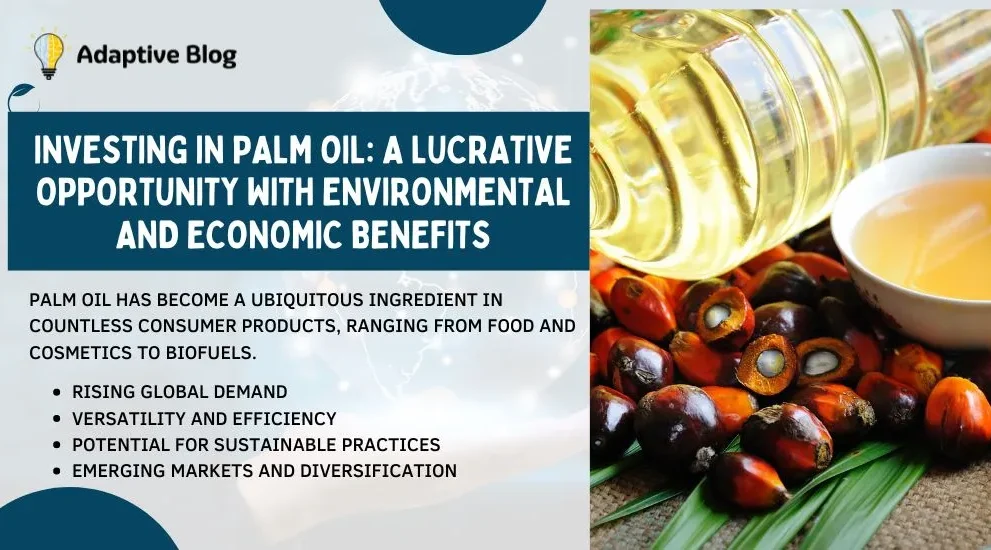Investing in Palm Oil: A Lucrative Opportunity with Environmental and Economic Benefits

Palm oil has become a ubiquitous ingredient in countless consumer products, ranging from food and cosmetics to biofuels. Its versatility and economic significance have made it a sought-after commodity, attracting the attention of investors worldwide. While palm oil production has faced criticism for its environmental impact, savvy investors recognize the potential for sustainable practices and profitability within this industry.
The Benefit of Investing in Palm Oil Industry
Rising Global Demand:
Palm oil is the most widely consumed vegetable oil globally, with its demand steadily increasing due to population growth and changing dietary habits. As emerging economies expand and urbanize, the demand for processed foods and personal care products containing palm oil continues to rise. This growing demand presents a compelling investment opportunity for those looking to capitalize on a thriving market.
Versatility and Efficiency:
One of the key attractions of palm oil is its versatility. It is used in a wide array of products, including cooking oil, margarine, soap, shampoo, and biodiesel. This diverse application makes palm oil a resilient investment, less susceptible to fluctuations in any single market sector. Additionally, investing in palm oil production is highly efficient, yielding significantly more oil per hectare of land compared to other vegetable oils, which enhances its profitability potential.
Potential for Sustainable Practices:
While palm oil production has been criticized for its environmental impact, there is a growing movement towards sustainable practices within the industry. Companies are increasingly adopting certifications such as Roundtable on Sustainable Palm Oil (RSPO), which promotes environmentally and socially responsible palm oil production. Investing in palm oil companies committed to sustainable practices not only mitigates environmental risks but also aligns with the growing consumer demand for ethically sourced products.
Emerging Markets and Diversification:
Palm oil production is concentrated in regions such as Southeast Asia, particularly Indonesia and Malaysia. Investing in palm oil provides exposure to emerging markets with significant growth potential. Moreover, for investors seeking diversification, palm oil offers an opportunity to access markets beyond traditional asset classes, such as stocks and bonds.
Government Support and Infrastructure Development:
Many palm oil-producing countries offer government support and incentives to attract investment in the industry. This includes infrastructure development, tax incentives, and favourable regulatory policies. Such support fosters a conducive environment for investment and ensures the long-term viability of palm oil production.
Resilience Amidst Economic Uncertainty:
Palm oil has historically demonstrated resilience amidst economic uncertainty. During periods of economic downturns, consumer demand for essential products like food and personal care items remains relatively stable, providing a buffer against market volatility. This inherent resilience makes palm oil an attractive investment option, particularly during times of economic uncertainty.
Profit of Palm Oil Production
The yearly profit of investing in palm oil production can vary significantly depending on various factors such as the scale of production, location, market prices, input costs, and efficiency of operations. However, to provide a general idea, let’s consider some key figures.
According to Palm Oil Analytics, on average, a well-managed palm oil plantation can yield around 3 to 8 metric tons of crude palm oil (CPO) per hectare per year. The price of CPO fluctuates based on global supply and demand dynamics, as well as geopolitical factors and changes in regulations affecting the industry. In recent years, the price of CPO has ranged from approximately $600 to $900 per metric ton.
Considering these figures, let’s calculate a rough estimate of yearly profit for investing in palm oil plantation:
- Yield per hectare: Let’s assume a conservative yield of 4 metric tons of CPO per hectare per year.
- Price of CPO: Taking an average price of $750 per metric ton.
- Cost of Production: This can vary widely depending on factors such as labor costs, fertilizers, pesticides, land lease or ownership costs, and infrastructure expenses. For the sake of simplicity, let’s assume a cost of production of $400 per metric ton of CPO.
Now, the calculation for yearly profit would be:
Yearly Profit per Hectare=(Price of CPO−Cost of Production)×Yield per hectare
=(750−400)×4
= $1,400
This is a simplified calculation and actual profits can vary widely based on specific circumstances and market conditions. Additionally, it’s important to consider other factors such as initial investment, ongoing maintenance costs, and potential risks such as weather events, diseases, and market volatility. However, this estimation gives a rough idea of the potential profitability of investing in palm oil production per hectare per year.
Also Read: Elevating Home Comfort: The Benefits of Water Booster Pumps
Conclusion
Investing in palm oil presents a compelling opportunity for investors seeking both financial returns and positive environmental impact. While challenges exist, such as environmental concerns and social responsibility, the industry’s commitment to sustainability and innovation is driving positive change. By embracing sustainable practices and capitalizing on rising global demand, investors can position themselves to benefit from the lucrative opportunities offered by the palm oil industry.





